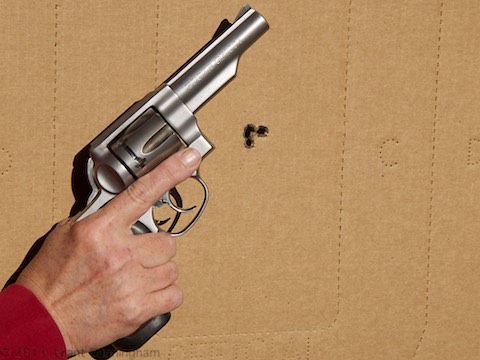Revolver Knowledge: Resetting the double-action trigger

A revolver shooting issue that comes up frequently is resetting the double-action trigger (or, more correctly, allowing the trigger to reset.)
This problem seems to be more common among those who are accustomed to shooting autoloading pistols, as they tend to develop habits that shooters of lesser experience do not. (I’m not saying the problem is exclusive to that group, mind you, but they exhibit it to a much greater degree than their less-experienced counterparts.) I also see it in supposedly experienced and knowledgeable instructors!
Catching the link
In recent years it’s become very fashionable to shoot autoloaders by allowing the trigger to reset only enough that the sear is re-engaged. This reduces the trigger’s travel by a fraction of an inch, which makes it ever so slightly faster than waiting for the trigger to reset completely. This used to be called “riding the reset” or “catching the link”, though I’m sure the Cool Kids have another name for it these days. I don’t try to keep up with the latest in-group terms!
Regardless of the term, the only way to make the trick work is to be able to feel the slight “click” in the trigger when the sear re-engages. That’s the tactile clue the sear has reset and the trigger can be pressed again to fire another shot. If that click isn’t terribly distinct, it can’t be easily felt and the whole technique falls apart.
So popular is this technique that scarcely a pistol review is written where the reviewer doesn’t pass judgement on the trigger reset. This has been aided and abetted by manufacturers, particularly those of aftermarket triggers, who build stronger and more distinct reset indications into their triggers to please that portion of the market.
(As a competition shooting technique, shooting to the reset has merit; as a defensive shooting technique, it’s nothing more than a distraction. I submit that anyone worrying about the trigger reset on their defensive pistol has failed to understand the task at hand. I’ll tackle that subject in a future article.)
Enter the wheelgun
The person who’s used to shooting an autoloading pistol and feeling for that reset often has trouble with the very different revolver trigger. This is because most revolvers have what I’ve come to call “phantom reset points”: points in the trigger return stroke where the shooter feels telltale clicks that serve as a cue to pull the trigger again.
The trouble is that the revolver trigger isn’t yet reset, and pulling the trigger again on cue either does nothing — or, in the worst case, actually locks the trigger’s movement!
Where these reset points are depends on the make of the revolver and, sometimes, even the specific model. In general, though, Ruger revolvers have the most distinctive false resets; they’re also the ones that consistently lock the trigger when the shooter tries to fire another round after encountering the false reset. (Fixing that lock-up is a simple matter of relaxing the trigger finger and allowing the trigger to fully reset before trying to fire another shot.)
On any revolver, the only reliable reset point is at the forward-most point of trigger travel. Occasionally you may find an individual gun which resets just short of that, but in general the only real reset is when the trigger has stopped moving — and it’s the only proper way to train your trigger finger.
The revolver trigger reset
So, how do you reset the revolver trigger properly? By not trying to reset it!
I teach my students to reset the trigger by allowing their finger to “bounce” off the trigger ever so slightly. What I mean by this is allowing the trigger to reset all the way forward, far enough that as the finger continues moving, the now-stationary trigger allows the compressed flesh of the finger’s pad to expand nearly back to normal. Once that “re-inflation” has been felt, another shot can be initiated.
This technique usually eliminates the problem of the false reset. The most important thing is to complete ignore any tactile sensation which suggests the trigger has reset before that point.
Note that the trigger finger is not necessarily coming completely off the trigger. I like to maintain just enough contact so that my trigger finger is at the same place on the face of the trigger. Allowing the pad to re-inflate suffices to do that and still allows a full trigger reset. If the finger does come off the trigger face just a little, I don’t worry about it as long as the shooter demonstrates good control.
This is sometimes derided as “slapping the trigger” by many shooters. But, as Rob Leatham is fond of showing, trigger slap isn’t a problem if the gun is being grasped correctly in the first place.
Do the bounce
If the revolver trigger has not reached its forward stopping point, it has not reset properly. The only way to allow it to do so is to give it enough room under the trigger finger to move all the way forward. The only way I’ve found to ingrain the habit in myself and in my students is to teach the “trigger finger bounce”.
Revolvers aren’t autoloaders. If you try to shoot them as though they are, you’re not going to have a good time. Learn how and why the revolver trigger resets as it does, and you’ll find it easier and more rewarding to shoot!
— Grant Cunningham
P.S.: Speaking of revolvers for self defense, if you have one you should also have a copy of my groundbreaking book Protect Yourself With Your Snubnose Revolver! It teaches you how to efficiently and effectively use your revolver in a defensive encounter, and it’s available in Kindle, iBooks, and paperback versions.
Listen to this blog – and subscribe to it on iTunes by clicking this link!
- Posted by Grant Cunningham
- On November 5, 2018

